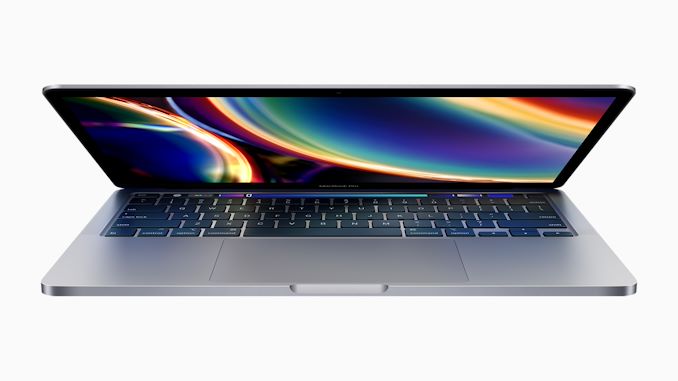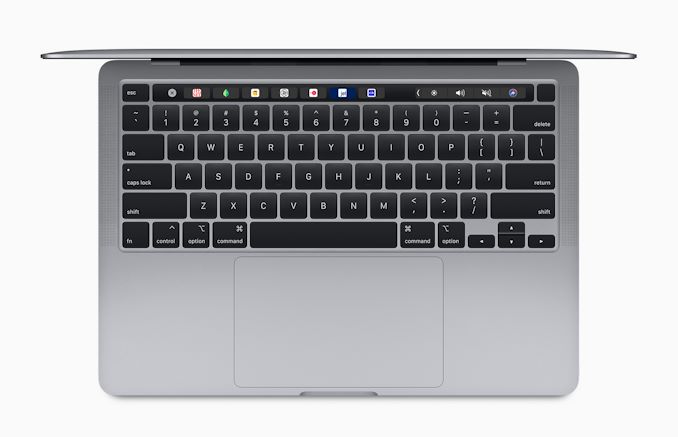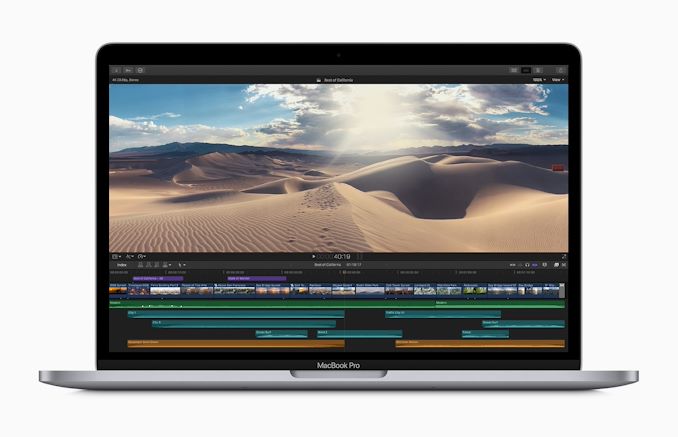Apple Launches New 13" MacBook Pro: 10th Gen Ice Lake and New Scissor Keyboard
by Andrei Frumusanu on May 4, 2020 10:00 AM EST
Today Apple is releasing new revamped versions of its 13” MacBook Pro line-up, most notably updating the series with the new scissor-switch style Magic Keyboard, as well as giving the option for Intel’s new 10th generation Ice Lake CPUs in the higher end models.
Apple last winter had rolled out its new 16” MacBook Pro which had introduced the new Magic Keyboard, making the choice to drop the controversial butterfly switch keyboard back to a scissor switch design. Today’s 13” line-up adopts the same changes across the smaller form factor models, including the new Touch Bar design that has been narrowed down to now include a physical escape key on the keyboard.
The new design otherwise doesn’t significantly diverge from its summer-2019 refresh, although this year it’s every so slightly thicker at 1.56cm instead of 1.49cm – certainly unnoticeable in everyday usage. It’s also 30g heavier at up to 1.4kg now (3.1lbs).
The most significantly internal change is the option for a new 10th generation Intel Ice Lake based CPU, running at 2.0GHz base clocks and Turbo Boost to up to 3.8GHz. As always with Apple products, this likely is a custom SKU just for Apple’s line-up as there’s no matching public part with these frequencies – the closest part is an i7-1060G7 which features the same peak clock, but only a meagre 1.0GHz base clock. Apple here likely is running a higher base TDP of 20-25W. For a $200 upsell, you can choose a higher-end 2.3/4.1GHz CPU configuration.
Edit May 10th: Intel has added the new i5-1038NG7 and i7-1068NG7 to their Ark database. These are 28W processors.
Whilst the Ice Lake based parts are new, Apple will continue to sell 8th generation Coffee Lake based parts at the lower end price spectrum in the $1299 and $1499 price points. Aside from the CPUs themselves, the two generational offerings of CPUs will also differ in their DRAM configuration as the new ICL parts come with 16GB of LPDDR4X-3733, whilst the CFL parts continue to just offer 8GB of LPDDR3-2133. The ICL parts are upgradeable to 32GB for an extra $400, and the CFL parts upgrade to 16GB for $100.
The display panel seemingly remains unchanged, featuring a 13” 2560 x 1600 IPS LCD panel with a wide Display P3 colour gamut, 500 nits peak brightness, and True Tone ambient colour adjustment.
| MacBook Pro 13-Inch 2020 | ||||
| Model | 2020 13-Inch Higher-End |
2019 13-Inch Higher-End |
2018 13-Inch Entry-Level |
|
| CPU | 2.0 GHz/3.8 GHz Core i5-1038NG7 2.3 GHz/4.1 GHz Core i7-1068NG7 4 CPU Cores (Ice Lake) |
2.4 GHz/4.1 GHz Core i5-8???U 4 CPU Cores (Coffee Lake) |
1.4 GHz/3.9 GHz Core i5-8???U 4 CPU Cores (Coffee Lake) |
|
| GPU | Intel Iris Plus | Intel Iris Plus 655 (128MB eDRAM) |
Intel Iris Plus 645 (? eDRAM) |
|
| Display | 13" 2560 x 1600 IPS LCD DCI-P3 Gamut True Tone |
|||
| Memory | 16 GB LPDDR4X-3733 | 8 GB LPDDR3-2133 | ||
| SSD | 512 GB PCIe SSD | 256 GB PCIe SSD | 128 GB PCIe SSD | |
| Touch Bar | Yes | |||
| I/O | 4x Thunderbolt 3 (supports DP1.2 & USB 3.1 Gen 2 modes), 3.5mm Audio |
2x Thunderbolt 3 (supports DP1.2 & USB 3.1 Gen 2 modes), 3.5mm Audio |
||
| Battery Capacity | 58 Wh | 58.2 Wh | ||
| Battery Life | 10 Hours | |||
| Dimensions | 1.56 cm x 30.41 cm x 21.24 cm | 1.49 cm x 30.41 cm x 21.24 cm | ||
| Weight | 3.1 lbs (1.4 kg) | 3.02 lbs (1.37 kg) | ||
| Launch Price | $1799 | $1799 | $1299 | |
Connectivity-wise, the new 2020 13” MacBook Pros come in two flavours: the lower-end $1299 and $1499 Coffee Lake based models feature two Thunderbolt 3 ports, whilst the Ice Lake based parts get four. We also see an addition of a 3.5mm headphone jack. Unfortunately, Apple seemingly hasn’t upgraded the Wi-Fi on the new models, and WiFi 6 / 802.11ax still isn’t present as they still make due with WiFi 5 / 802.11ac capability.
Battery-wise, there’s no changes in capacity as we’re still looking at a 58Wh unit, and Apple claims an identical “10 hours” of usage for all new models – the same as last year’s Coffee Lake models.
The higher-end Ice Lake parts come now with the aforementioned base 16GB of DRAM config at a $1799 price point with a 512GB SSD, or a $1999 option with a 1TB SSD. Storage configurations for the ICL models are doubled across the board, with the possibility to choose up to a 4TB configuration for an extra $1200.
The new 13" MacBook lineup is available for order directly from Apple starting today.
Related Reading:
Source: Apple












85 Comments
View All Comments
tipoo - Monday, May 4, 2020 - link
Continuing to use 8th gen on the two port models is a bummer. Chip constrained maybe? I'd hope it's not an artificial gimp, it's a weird lineup because the Air is also all on 10th gen now, which had better single threaded and GPU performance (in a burst) than the 8th gen Pros.Soppro - Monday, May 4, 2020 - link
Indeed it is weird, perhaps they couldn't secure enough of those 10nm chips from Intel?ingwe - Monday, May 4, 2020 - link
I am hoping that a lack of availability is the reason. That is the only decent reason imo. Even still it is not great that they are still selling old chips.tipoo - Monday, May 4, 2020 - link
It makes the two port Pro such an awkward model. On a sustained load it'll beat the Air, but the Air was faster than the 8th gen Pros in single threaded and GPU bursts. For someone with modest needs I'd recommend the quad core Air, for a CPU upgrade you'd have to go all the way up to the four port Pro, I can't see where I'd ever recommend the awkward middle child.plewis00 - Monday, May 4, 2020 - link
Except the Air has the clever 'fan that does nothing' setup, so for that reason alone, the Pro is probably the better buy as it's actually engineered properly.tipoo - Wednesday, May 6, 2020 - link
"On a sustained load it'll beat the Air". But for most bursty work the Air would come ahead, which makes the choice between them a little weird.psychobriggsy - Monday, May 4, 2020 - link
It does suggest that Intel couldn't guarantee enough higher-end IceLakes (15-28W) for Apple's expected 13" MBP sales volume. Sure, plenty of 12W i3s and i5s for the MBAs.Which as that isn't overly massive, is not a good sign regarding Intel's 10nm volume/yield.
Maybe they're busy fabbing TigerLakes for September.
yankeeDDL - Monday, May 4, 2020 - link
It seems that 10nm compared to a 14nm+++++ brings lower consumption but also lower clock speed. It is not obvious that the 10th gen is "better" than the 8th.tipoo - Monday, May 4, 2020 - link
The higher wattage 28W model gets the 10th gen, while the 15W model does not, and also the sub 10W Air has 10th gen.In this class it would definitely have been an improvement for the 15W model.
Deicidium369 - Monday, May 4, 2020 - link
higher IPC on Ice Lake. So a lower clocked Ice Lake can easily best a higher clocked 14nm